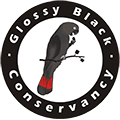Glossy Black-Cockatoo
Conservation Guidelines
The Glossy Black-Cockatoo Calyptorhynchus lathami is listed as a threatened species under Queensland and New South Wales legislation. South-eastern Queensland (SEQ) and north-eastern New South Wales (NENSW) have some of the most significant populations of the species in Australia. Currently, no integrated protection programs (such as recovery plans, breeding programs or population monitoring) exist for the Glossy Black-Cockatoo in these regions. This represents a significant limitation to ensuring the bird’s conservation.
The Glossy Black Conservancy was formed with the vision of enabling a coordinated approach between government, community and business to increase the awareness, protection and conservation of Glossy Black-Cockatoos within SEQ. The geographical scope of the Conservancy was soon extended to include NENSW. To achieve this vision, and to address the lack of an established plan of management, Conservation Guidelines were developed in 2009.
The objective of the Conservation Guidelines is to facilitate the conservation of viable populations of Glossy Black-Cockatoo and their habitats across SEQ and NENSW through;
- Improving knowledge and understanding of the ecological interactions between Glossy Black-Cockatoos and both natural and modified environments,
- Identifying threats to Glossy Black-Cockatoo persistence across SEQ and NENSW and priority actions for conservation;
- Providing stakeholders with relevant information to develop and implement strategic, adaptive management actions and associated monitoring regimes that achieve the conservation objectives for the Glossy Black-Cockatoo and its habitats;
- Assisting the implementation of management actions by coordinating a consistent, collaborative effort by stakeholders;
- Raising public awareness of the Glossy Black-Cockatoo, the threats it faces, and the priority actions required to ameliorate these threats.
The updated version represents the first revision of the Conservation Guidelines, with the inclusion of new research findings regarding the species and threats to its status and recovery, updated information about existing and potential mechanisms available for species protection and recovery, and a revised list of broad actions and priorities for research, regulatory planning/policy and general land management based on known threats and knowledge gaps. The document is intended to be a compendium of current knowledge about the Glossy Black-Cockatoo and its conservation needs in SEQ and NENSW.
The long-term goal of these Conservation Guidelines is to facilitate the conservation of viable populations of Glossy Black-Cockatoo in the regions of SEQ and NENSW active in the Conservancy. This will require the effective management of relevant threats to prevent further population decline and facilitate recovery. Management outcomes must also be monitored to measure their effectiveness and ensure the appropriate allocation of resources.
Conservancy partners are primarily responsible for implementing and facilitating implementation of the recommended actions within this new version of the Conservation Guidelines; however, the participation of numerous other stakeholders, including other government agencies, researchers, non-government organisations (corporate and not-for-profit) private land managers, and Friends of the Conservancy will be critical for achieving desired outcomes.
It is also acknowledged that most new sightings and records of Glossy Black-Cockatoo in SEQ and NENSW come from the wider community and that monitoring of the species is more easily and effectively undertaken by local residents and visitors. As such, public participation remains crucial to ensuring a more secure future for the bird. The habitual nature of the species provides an additional linkage to community-based monitoring, facilitating year-round observation of the use of habitat elements such as watering sites and feed resources.
Feature image: Andrew Peacock (www.footloosefotography.com)
Download the guidelines here
